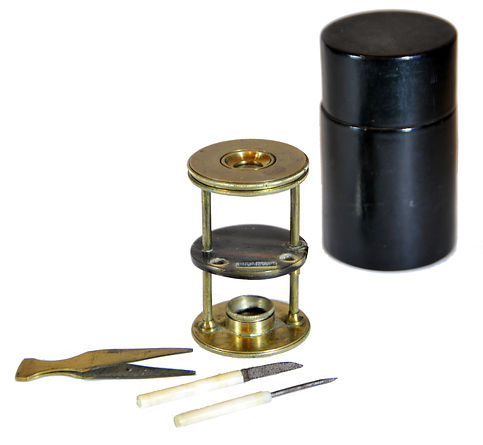

Withering-type botanical microscope, 1780
The “Withering-type Microscope” is named for its inventor, Dr. William Withering (1741-1799), an English physician and botanist who graduated with a degree in medicine 1766 in Edinburgh. Inspired by the taxonomical work and systematic classification of Carl Linnæus (1707-1778), Withering (1776) applied the Linnaean taxonomical system of classification to British plants in a seminal, two volume work, A Botanical arrangement of all the vegetables naturally growing in the British Isles. The earliest reference to a small botanical microscope of Withering’s design appeared in the first edition of this book. There, Withering indicated this microscope was developed for field dissections of flowers and other plant parts. While there is no surviving example of this exact design, close relatives of this type do exist, made either completely of brass or of ivory with brass pillars. Ivory models can be tentatively dated to 1776-1785, as by 1787 a newer model with a hollowed stage in an all-brass configuration already predominated. In turn, it was preceded by the brief appearance of a transitional brass model but with solid stage of ivory or horn (seen here). This version is extremely rare and must have been produced in very small numbers. By 1787 all these varieties were not recorded anymore in the literature.

Withering-type botanical microscope, 1780
The “Withering-type Microscope” is named for its inventor, Dr. William Withering (1741-1799), an English physician and botanist who graduated with a degree in medicine 1766 in Edinburgh. Inspired by the taxonomical work and systematic classification of Carl Linnæus (1707-1778), Withering (1776) applied the Linnaean taxonomical system of classification to British plants in a seminal, two volume work, A Botanical arrangement of all the vegetables naturally growing in the British Isles. The earliest reference to a small botanical microscope of Withering’s design appeared in the first edition of this book. There, Withering indicated this microscope was developed for field dissections of flowers and other plant parts. While there is no surviving example of this exact design, close relatives of this type do exist, made either completely of brass or of ivory with brass pillars. Ivory models can be tentatively dated to 1776-1785, as by 1787 a newer model with a hollowed stage in an all-brass configuration already predominated. In turn, it was preceded by the brief appearance of a transitional brass model but with solid stage of ivory or horn (seen here). This version is extremely rare and must have been produced in very small numbers. By 1787 all these varieties were not recorded anymore in the literature.
References: SML: A242712; Goren 2014.
References: SML: A242712; Goren 2014.
Prof. Yuval Goren's Collection of the History of the Microscope
20th Century toy microscopes tell their stories
Kleines Mikroskop ATCO, 1934
Bar Mitzvah Gift to Yosef Leschner, Saarbrücken, 24/4/1934.

August Töpfer & Co. (ATCO GmbH) was founded in 1912 by August Toepfer in Erfurt, Germany, as a wholesaler of imported commodities. After the death of the founder in 1918, the company was taken over by a group of five shareholders. After Word War II the company gave up the former headquarters in East Germany and relocated to the still existing branch office in Hamburg.
The little microscope seen here has one linear magnification of 70x. It was the Bar Mitzvah gift to Yosef (Joseph) Leschner of Saarbrücken, Zeeland (then capital of the autonomous Saar territory), given to him by his parents on April 24th, 1934.
Yosef was born in Saarbrücken on April 24, 1921 to his parents Dorithea (Donia) and Sigmund Leschner. Sigmund was a senior engineer at a mining company. After the referendum in which the inhabitants of the Saar decided to join Germany, he realized that this would not be a good place for Jews. In 1936 he immigrated with his parents to Palestine (then under British mandate), to escape Nazi Germany.

Sigmund Lescner was an important citizen of his city, and when they boarded the train, they were accompanied by many residents of the city, and the fire brigade orchestra played. As they arrived in Jaffa, then in Palestine under British mandate, he was employed by the Palestine Potash Company and later by the Technion Institute of Technology in Haifa. They lived for a short time in Jerusalem and then moved to Haifa, where their son Yosef studied in the first year of Basmat School. For ideological reasons and to the dismay of his parents, he did not finish high school and, at the age of 17, joined his friends in a commune of workers and for about a year and a half worked as a laborer in the port of Haifa. In 1940, he and his friends joined the nucleus of Kibbutz Mishmar HaEmek, where he lived until he died in 2004.
During Israel's War of Independence, Yosef joined the Fifth Regiment of the Hare'l Brigade and participated in the battles of Jerusalem and the Negev. He graduated from an officers' course in 1949 and was later discharged from the army.
Yosef Leschner, 1921-2004
The microscope with the homemade slides of apple skin, hair, onion epidermis, spider web and live onion, was contributed to this collection by Yosef's daughter Hagar Leschner, now retired Collection Manager of The Herbarium of The National Natural History Collections at the Hebrew University, Jerusalem. As a child, Hagar received this microscope from her father, together with the Hebrew captioned slides that were made for her by her father.